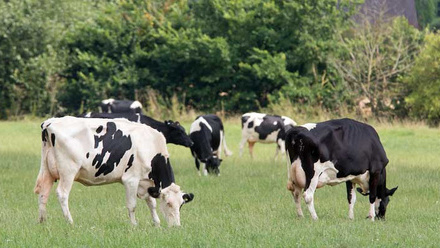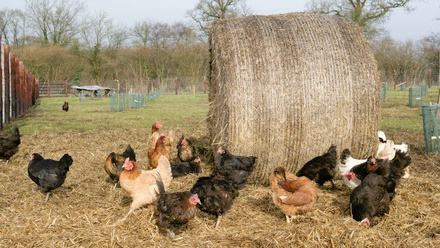Notifiable Diseases Movements Guidance
Movements onto and off of livestock farms
Rationale for disease control
Part 1
Rationale for disease control during visits to livestock farms
Foot-and-Mouth Disease (FMD), Avian Influenza (AI), Classical Swine Fever, African Swine Fever and certain other notifiable disease organisms can survive for long periods outside animals.
Defra advises that materials such as manure, slurry, animal bedding and feedstuffs can carry viruses and these may be picked up on hands, vehicles, clothing or other equipment and from there thedisease can be transmitted to other animals, unless precautions are taken.
It is essential that all these things are cleansed and disinfected to remove all traces of faecal and other potentially infected material (used bedding, used feedingstuffs, animal or poultry products etc).
Cleanse AND Disinfect
Throughout this document, the term "cleanse and disinfect" is used.
This is because the Defra-approved disinfectants that are suitable for spraying onto vehicles are not effective if the surface onto which they are sprayed is dirty.
Most are effective if the vehicle has only a light covering of traffic film, (for example, a feed material delivery vehicle that has travelled on motorways and major roads from a port store to a feed mill,) but they are not effective if sprayed onto a much thicker layer of dirt that might be found under the wheels arches and chassis, on the mud flaps and on the wheels of a vehicle that has been on some local and farm roads.
In this case, the dirt needs to be removed, usually by pressure washing, before the disinfectant is applied. The application instructions supplied with the disinfectant should give further details.
The instructions in this protocol reflect the need to apply different levels of cleansing and disinfection to vehicles used for different purposes and at different times of the day.
In this document, wherever cleansing and disinfection of wheels, wheel arches and mud flaps is referred to, this should also be taken to include transportable blower pipes, hose reels, grain socks etc. where these are used.
NOTE: Bluetongue and African Horse Sickness are transmitted by midge vectors and this protocol does not apply to them. Adherence to this protocol will also reduce the risk of spreading many other endemic diseases between farms.
What happens if disease is suspected?
Premises restrictions
If disease is suspected on a farm, the premises will be put under restrictions. The Animal and Plant Health Agency (APHA)will license necessary movements onto and off-premises and the existence of these restrictions will be clear from notices and/or the presence of APHA staff at the entrance to the premises.
If disease is not confirmed, the premises and movement restrictions will be removed.
Area restrictions
On suspicion of disease, Defra might impose wider controls on the movement of animals, animal products and other biosecurity measures in a Temporary Control Zone. At this stage, all those involved in movements onto and off premises with susceptible animals in any Temporary Control Zone should adopt the principles of “clean on and clean off”.
If disease is confirmed, an Infected Area around the premises will be declared and is likely to consist of a Protection Zone (highest risk, minimum 3 km) and a Surveillance Zone (somewhat lesser risk, minimum 10 km) with strict biosecurity controls for premises and movements.
Wider movement restrictions (perhaps national) might be introduced although these may be restricted to livestock movements.
At this stage, the Protection Zone and Surveillance Zone requirements will usually require biosecurity measures that should be met by the adoption of this protocol, and in any other zones, its adoption should be considered.
Once the outbreak has been brought under control and there are no new cases in the area, the Protection Zone will merge with the Surveillance Zone and, after Defra is content that disease no longer exists in the area, the controls will be removed.
Traceability of vehicle movements
As soon as APHA considers that disease is likely to exist on a premises, movements of people and vehicles to and from the premises will be established to allow tracing. A delivery lorry likely to go to other farms that had recently been on such a premises would be considered a high-priority (“hot”) tracing by the veterinary epidemiologists and the company concerned would be contacted once disease has been confirmed.
Defra advice
Further advice on disease prevention and good hygiene procedures can be found on GOV.UK.
Defra Interactive Map
An interactive map will go live on the Defra website when there is an outbreak of an exotic notifiable disease. This web-based based interactive map tool will display the various restriction zones put in place.
These zones will vary according to disease and the control strategy that is implemented for each outbreak. At present the map will only go live on confirmation of disease.
The map will allow members and the general public to see if they fall within any of the restriction zones by searching by a place name, postcode or map reference. Using the postcode facility you will also be able to determine whether your delivery /collection points fall within a particular zone and delivery/collection routes can be planned accordingly.
The interactive map can be accessed via GOV.UK. There will be a link to the particular disease outbreak.
Part 2
Licences and Legislation
Where collections and/or deliveries are made to premises in controlled zones, legislative requirements will require strict biosecurity which require a “clean on and clean off” policy.
Vehicle wheels, mud flaps and wheel arches must be cleansed and disinfected on entering and leaving premises, visible contamination of the rest of the vehicle must be removed before entering or leaving premises and personal biosecurity protocols (for example the use of overshoes, disposal overalls) should be followed.
The Defra website or the local Animal Health Regional Office should be consulted if there is any doubt about biosecurity requirements in controlled zones.
However, collections and deliveries to premises under specific restrictions, such as suspect premises (under investigation) or dangerous contacts will require liaison with the farmer and APHA, who will provide a specific licence for movements of the vehicle on to and off the premises and will provide full instructions on biosecurity to be followed.
It is possible that certain disease control legislation will ban the movement of fodder (which includes all types of feedingstuffs) on to and off-premises with susceptible animals in a zone unless such moves are licensed. If such licences are made available they are likely to be “General”.
General licences are published on the Defra website. They do not have to be applied for, but can be viewed and downloaded.
So long as the person making the move complies with the conditions of the licence, the move can be undertaken without informing Defra or the local authority.
When making a move under a general licence, the person making the move must carry a copy of the licence and a consignment note with full details of the move and what is being moved.
Part 3
This Part represents a typical protocol for application to all visitors to livestock premises in those parts of the country where a Protection Zone and Surveillance Zone have been established.
Farm advisors and representatives
All visits should be by appointment and only if necessary. If you are visiting the farm office, farmhouse or those parts of the farm or fields where you will have no contact with animals or the animal area, then minimal biosecurity is needed (ie ensure your vehicle, clothing and footwear are clean so that any possible contamination from a previous visit cannot be introduced to the farm).
However, if you have gone over any part of the farm premises, which means that the vehicle could be contaminated with soil or faecal material then "clean off" protocols should be followed.
If you do, however, come into contact with animals or animal areas then you will need to undertake full biosecurity procedures (as for a delivery vehicle).
Deliveries and collections
Planning
The disease or biosecurity status of the farm should be known prior to delivery using the interactive map if necessary. For multiple pick-Ups or multiple deliveries, the route must be planned such that deliveries to premises in the lowest risk areas are made first (always go up the “risk gradient‟).
Prior to Delivery
All vehicles must leave the depot in a clean state.
On Arrival at Delivery Site
Where required on arrival at the farm the driver should make contact with farm staff prior to entering the site – for example by ringing a bell or telephoning. In addition, drivers may be required to complete and sign the Visitors Book before entering the unit.
Drivers must ensure their vehicles are clean when entering the site and have wheels and wheel arches cleansed and disinfected.
Drivers must wear disposable overalls and overshoes or wellingtons provided on the premises, and carry them in case they are not provided – they must be put on when leaving the cab.
Drivers should ensure that they do not wear “dirty” footwear or clothing in the cab of the vehicle so that contamination from one farm cannot be carried to another. Where it is a site requirement for the driver to shower, he should do so.
Vehicles operating in the Protection Zone or Surveillance Zone should carry with them a knapsack disinfectant sprayer for use if one is not provided at the premises. Drivers should be trained in the safe use of disinfectants.
Disinfectants used should be approved under The Diseases of Animals (Approved Disinfectants) (England) Order 2007 (equivalent legislation exists in Scotland, Wales and Northern Ireland).
A list is available on GOV.UK.
While on site
Drivers must avoid all contact with livestock and farm pets, must not enter any livestock sheds and must stay with theirvehicle.
Prior to Leaving Delivery Site
Any spillages that might attract pests must be cleaned up.
Any protective clothing used must be left behind on departure, preferably at the exit, for the farmer to dispose of. All effortsmust be made to minimise presence on site without protective clothing. Boots that are taken away must be cleansed anddisinfected.
Drivers must ensure their vehicles are clean when leaving the premises, the wheels and wheel arches cleansed anddisinfected. (The area sprayed should include the side, front and rear of the vehicle, the wheels and wheel arches and anyother potentially contaminated items of equipment)
Feed stocks at infected premises after slaughter of animals must not be removed.
Pallets, Tote Bags or similar items must not be removed from premises within Protection and/or
Surveillance Zones for the duration of the disease control precautions.
Action at the Feed Mill, Grain Store or Similar non-‐Farm Operating Premises
Basic biosecurity measures including the need to maintain vehicles in a clean state and remove any build-up of soil or faecalcontamination should be followed at all times.
When a disease outbreak has been notified in an area any vehicle entering or leaving a feed mill site within it must besprayed with disinfectant or driven through a wheel dip which is long enough and deep enough to ensure that disinfectantsoaks the wheels and is thrown up into the wheel arches. Alternatively, it may be considered more appropriate or effective topressure wash the outsides of all vehicles entering the feed mill site.
At the end of each day the entire exterior of the vehicle must be thoroughly cleansed and disinfected, to remove all dirt and inparticular any faecal material.
Foot well mats must be removed from the cab and cleansed daily. If disinfected they need to be aired before they are placedback into the cab and full consideration must be given to the Health and Safety implications of the risk of the presence ofdisinfectant within a lorry cab.
Records of all driver, vehicle and trailer movements must be retained along with records of all vehicle cleaning.
The Defra website contains comprehensive information on disease surveillance and control as well as health and safetyinformation for staff. The link to the website is:
18/11/14




